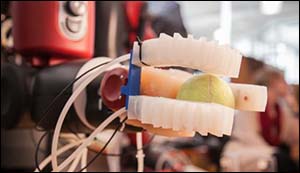Soft robotic hand can pick up and identify a wide array of objects
2. 10. 2015 | CSAIL | www.csail.mit.edu
Robots have many strong suits, but delicacy traditionally hasn’t been one of them. Rigid limbs and digits make it difficult for them to grasp, hold, and manipulate a range of everyday objects without dropping or crushing them.
Recently, CSAIL researchers have discovered that the solution may be to turn to a substance more commonly associated with new buildings and Silly Putty: silicone. At a conference this month, researchers from CSAIL Director Daniela Rus’ Distributed Robotics Lab demonstrated a 3-D-printed robotic hand made out of silicone rubber that can lift and handle objects as delicate as an egg and as thin as a compact disc.

Just as impressively, its three fingers have special sensors that can estimate the size and shape of an object accurately enough to identify it from a set of multiple items. The gripper, which can also pick up such items as a tennis ball, a Rubik's cube and a Beanie Baby, is part of a larger body of work out of Rus’ lab at CSAIL aimed at showing the value of so-called “soft robots” made of unconventional materials such as silicone, paper, and fiber.
Researchers say that soft robots have a number of advantages over “hard” robots, including the ability to handle irregularly-shaped objects, squeeze into tight spaces, and readily recover from collisions.
Read more at CSAIL
Image Credit: CSAIL
-jk-




